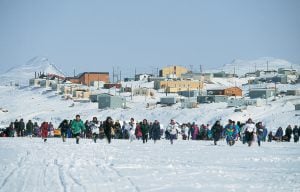Shamans (left) mediated between Inuit and Sedna — also known as Nuliajuk, Taliilajuq, Uinigumasuittuq and Takannakapsaaluk (right, shown in her origin story, falling into the sea) — and other spirits that influenced Inuit life. (Left: Germaine Arnaktauyok, At The Height of His Power/courtesy of Inhabit Media; right: Germaine Arnaktauyok: Sedna — The Storm/courtesy of Inhabit Media)
From Shamans, Spirits, and Faith in the Inuit North
The wisdom of Aua
It was February 1922. Knud Rasmussen was travelling by sled with his Polar Inuit companions along the shores of Foxe Basin, north of Lyon Inlet. They were about to make camp for the night when suddenly, out of the darkness, appeared a team of fifteen white dogs pulling a long sled carrying six men. Sighting the party of strangers, a small man with a long beard, his face framed in ice and snow, leapt from the sled and ran towards Rasmussen. This, wrote Rasmussen, was Aua, the shaman.
Rasmussen’s mission was to study and record the myths and legends, the beliefs and the life stories of the Inuit of Canada, who had had little contact with outsiders. He spoke Greenlandic fluently, and so he was easily able to understand the dialects he encountered on his sled-quest across Canada’s North. He had heard of Aua from Inuit he had already met in Foxe Basin and was overjoyed to finally meet him. From Aua, his garrulous wife Orulo, and the others who lived in Aua’s camp, Rasmussen learned much about the customs of the Inuit.
Through several evenings of discussions with the men of the camp about the rules and taboos that governed life, it was apparent that everyone knew what had to be done in any given situation. But Rasmussen wanted to know more. He wanted to know why. And to this simple question, he wrote, they could give no answer. “They regarded it as unreasonable,” he added, “that I should require not only an account, but also a justification, of their religious principles.”
One evening, unable to answer the repeated question of “why,” Aua rose suddenly and invited Rasmussen to follow him outside, where a storm raged. He pointed to the ice and calmly remarked:
“In order to hunt well and live happily, man must have calm weather. Why this constant succession of blizzards and all this needless hardship for men seeking food for themselves and those they care for? Why? Why?”
By chance, hunters were returning from an unsuccessful day of hunting for seals at the breathing holes on the ice. Their efforts had been in vain, and Aua, turning the tables again, asked his companion, “Why?” Rasmussen could give no answer.
Aua led him to Kublo’s snow house, where the qulliq gave barely enough light and offered no heat to the children shivering under a skin blanket.
“Why should it be cold and comfortless in here?” the shaman asked. “Kublo has been out hunting all day, and if he had got a seal, as he deserved, his wife would now be sitting laughing beside her lamp, letting it burn full, without fear of having no blubber left for tomorrow. The place would be warm and bright and cheerful, the children would come out from under their rugs and enjoy life. Why should it not be so? Why?”
They continued to the house of Aua’s sister, Natseq, where Aua again questioned his questioner:
“Why must people be ill and suffer pain? We are all afraid of illness. Here is this old sister of mine; as far as anyone can see, she has done no evil; she has lived through a long life and given birth to healthy children, and now she must suffer before her days end. Why? Why?”
Silently they returned to Aua’s snow house and resumed their conversation. Aua began:
You see. You are equally unable to give any reason when we ask you why life is as it is. And so it must be. All our customs come from life and turn towards life. We explain nothing, we believe nothing. But in what I have just shown you lies our answer to all you ask.
We fear the weather spirit of earth, that we must fight against to wrest our food from land and sea. We fear Sila.
We fear dearth and hunger in the cold snow huts.
We fear Takannakapsaaluk, the great woman down at the bottom of the sea, that rules over all the beasts of the sea.
We fear the sickness that we meet with daily all around us; not death, but the suffering. We fear the evil spirits of life, those of the air, of the sea and the earth, that can help wicked shamans to harm their fellow men.
We fear the souls of dead human beings and of the animals we have killed.
Therefore it is that our fathers have inherited from their fathers all the old rules of life which are based on the experience and wisdom of generations. We do not know how, we cannot say why, but we keep those rules in order that we may live untroubled. And so ignorant are we in spite of all our shamans, that we fear everything unfamiliar. We fear what we see about us, and we fear all the invisible things that are likewise about us, all that we have heard of in our forefathers’ stories and myths. Therefore we have our customs, which are not the same as those of the white men, the white men who live in another land and have need of other ways.
This was Aua’s explanation. Clearly and calmly, he had outlined to Rasmussen why his question of “why” must remain an enigma.






